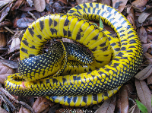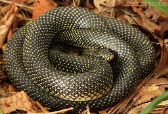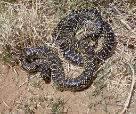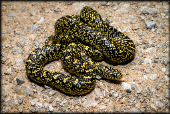Speckled Kingsnake (Lampropeltis holbrooki)
Description: The speckled kingsnake usually grows up to 48 in (120 cm) in total length (including tail), but the record total length is 72 in (180 cm). The common name is derived from its pattern, which is black, with small yellow-white specks, one speck in the center of almost every dorsal scale. It is also known as the "salt-and-pepper snake".[3]
Habitat: he speckled kingsnake prefers wetter habitats than other kingsnakes, such as swamps and rivers, but it does commonly venture to dry areas such as woodlands and grassy fields.
Range: The speckled kingsnake is found in the central and southern United States from southern Iowa to the Gulf of Mexico.[4] Its range overlaps that of the desert kingsnake, Lampropeltis splendida, and it is known to intergrade with that species.
Diet: The diet of the speckled kingsnake consists of mammals, birds, rodents, frogs, lizards, and other snakes. It kills by constriction.
Reproduction: Common kingsnakes mate in the spring, allowing females time to lay their eggs when the weather is still warm enough for proper incubation. Their gestation period is about 60 days. In warmer climates (e.g. Florida), courtship can begin as early as March. In northern portions of the range, courtship is delayed until April or May.
A female may produce a single clutch from multiple mates. Females may also produce more than one clutch per season as a result of more than one mating. The female chooses the nesting site, which can include rotting logs and stumps, as well as sawdust piles. Common kingsnakes breed yearly and have been known to produce more than one clutch per season. The breeding season is between March and August. The average number of offspring is 10 eggs per clutch (range 3 to 24). Average gestation period for female kingsnakes is 60 to 62 days (range 50 to 80 days). Hatchlings can weigh between 9 and 14 grams. Females reach sexual maturity at 2 to 4 years. Males reach sexual maturity at age 1 to 4.
Status: Listed as Least Concern in view of the large extent of occurrence, use of a broad range of habitats, large number of locations, presumed large population size, relatively stable or very slowly declining trend, and lack of major threats.
»» Kingdom: Animalia - Animals
»» Phylum: Chordata - Chordates
»» Subphylum: Vertebrata - Vertebrates
»» Class: Reptilia - Reptiles
»» Order: Squamata - Scaled Reptiles
»» Suborder: Serpentes
»» Superfamily: Colubroidea
»» Family: Colubridae - Colubrids
»» Genus: Lampropeltis
»» Species: Lampropeltis holbrooki - Speckled Kingsnake
This article uses material from the Wikipedia article "Speckled Kingsnake", which is released under the Creative Commons Attribution-Share-Alike License 3.0. Content may have been omitted from the original, but no content has been changed or extended.
|








